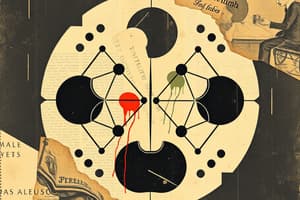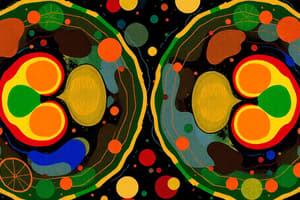Podcast
Questions and Answers
What is the main purpose of cell division?
What is the main purpose of cell division?
To bring about growth, replace damaged cells, and produce new generations of individuals.
What are the two kinds of cell division?
What are the two kinds of cell division?
- Mitosis
- Meiosis
- Both A and B (correct)
- None of the above
What is interphase?
What is interphase?
The resting stage of the cell cycle where the cell is not dividing but performs metabolic activities.
What are the three sub-phases of interphase?
What are the three sub-phases of interphase?
What does haploid refer to in terms of chromosomes?
What does haploid refer to in terms of chromosomes?
What is the diploid number of chromosomes in humans?
What is the diploid number of chromosomes in humans?
The acronym PMAT stands for the phases of mitosis: P – prophase, M – metaphase, A – ______, T – telophase.
The acronym PMAT stands for the phases of mitosis: P – prophase, M – metaphase, A – ______, T – telophase.
The S phase of interphase involves the doubling of DNA.
The S phase of interphase involves the doubling of DNA.
What is the process by which cells divide to support growth and replacement?
What is the process by which cells divide to support growth and replacement?
Which of the following are types of cell division?
Which of the following are types of cell division?
What are the three sub-phases/stages of interphase?
What are the three sub-phases/stages of interphase?
Haploid cells contain two complete sets of chromosomes.
Haploid cells contain two complete sets of chromosomes.
What happens during the S (synthesis) phase?
What happens during the S (synthesis) phase?
During which phase do chromatids align at the equator of the cell?
During which phase do chromatids align at the equator of the cell?
What is the acronym used to remember the phases of mitosis?
What is the acronym used to remember the phases of mitosis?
What is the final result of cytokinesis?
What is the final result of cytokinesis?
How many chromosomes do humans have in diploid cells?
How many chromosomes do humans have in diploid cells?
Flashcards are hidden until you start studying
Study Notes
Cell Division: Why Cells Divide
- Cells divide instead of growing indefinitely because diffusion, the process of nutrient uptake and waste removal, becomes less efficient as cell size increases.
Cell Cycle and Division
- Cell division is essential for growth, repair, and reproduction.
- Two types of cell division exist: mitosis (somatic cells) and meiosis (gametes).
- The cell cycle is the repeated process of cell division.
Interphase
- Interphase is the longest phase of the cell cycle (90%).
- It's a period of active metabolic activity, not cell division.
- Key activities include protein synthesis (cell growth) and DNA replication.
- Interphase has three sub-phases: G1 (Gap 1), S (synthesis), and G2 (Gap 2).
Chromosomes
- Diploid (2n) cells have two complete sets of chromosomes (one from each parent).
- Haploid (n) cells have one set of chromosomes.
- In humans, 2n = 46 (46 chromosomes total), and n = 23 (23 unique chromosomes).
Mitosis Stages:
G1 (Gap 1) Phase
- Longest phase of interphase.
- Cell grows to its normal size.
- Organelles are formed.
- Proteins, including enzymes needed for the S phase, are produced.
S (Synthesis) Phase
- DNA replication occurs, doubling the number of chromosomes.
G2 (Gap 2) Phase
- Cell prepares for division.
- Proteins like microtubules (essential for chromosome movement) are assembled.
Prophase
- Nuclear membrane and nucleolus dissolve.
- Chromatin condenses into visible, double-stranded chromosomes (chromatids).
- Chromatids are joined at the centromere.
- Spindle fibers begin to develop.
Metaphase
- Double-stranded chromosomes (chromatids) align at the cell's equator.
- Each chromatid attaches to the spindle via the kinetochore (structure in the centromere).
Anaphase
- Forces from the poles pull chromatids apart, separating them into single-stranded chromosomes.
- Chromosomes migrate to opposite poles.
Telophase
- Chromosomes reach opposite poles.
- Spindle fibers disappear.
- Chromosomes uncoil; the nucleolus and nuclear membrane reform.
- Cytoplasm divides (cytokinesis).
Cytokinesis
- A cleavage furrow forms.
- A new plasma membrane partitions the cell into two identical daughter cells.
- Each daughter cell has one chromatid per chromosome.
Mitosis Summary (PMAT)
- Prophase
- Metaphase (middle)
- Anaphase (away)
- Telophase
Chromosome and Chromatid Counts During Mitosis (Requires a table to be completed with data from the original text)
- The original text requires the completion of this table with data related to the number of chromosomes and chromatids during all the phases of mitosis. This information is not available in the provided text.
Cell Division: The Cell Cycle
- Cell division is crucial for growth, repair, and reproduction.
- Cells divide instead of growing indefinitely to maintain efficient nutrient diffusion.
Types of Cell Division
- Mitosis: Occurs in somatic (body) cells; produces identical daughter cells.
- Meiosis: Occurs in sex cells (gametes); produces genetically diverse haploid cells (sperm and egg).
The Cell Cycle
- The cell cycle is a continuous process of cell division and growth.
- Interphase (90% of the cycle) is the preparatory phase, comprising G1, S, and G2 phases.
Interphase Stages
- G1 (Gap 1): Cell grows, organelles form, and proteins for S phase are produced.
- S (Synthesis): DNA replication occurs, doubling the chromosome number.
- G2 (Gap 2): Preparation for cell division; proteins like microtubules are assembled.
Chromosomes
- Diploid (2n): Two sets of chromosomes (one from each parent). In humans, 2n = 46.
- Haploid (n): One set of chromosomes. In humans, n = 23.
Mitosis Stages - PMAT
- Prophase: Nuclear membrane and nucleolus dissolve; chromatin condenses into double-stranded chromosomes (chromatids) connected by a centromere; spindle fibers form.
- Metaphase: Chromosomes align at the cell's equator, attached to spindle fibers via kinetochores.
- Anaphase: Sister chromatids separate, becoming individual chromosomes; chromosomes move to opposite poles.
- Telophase: Chromosomes reach the poles; nuclear membrane and nucleolus reform; spindle fibers disappear.
Cytokinesis
- Cytoplasm divides, forming a cleavage furrow and two identical daughter cells, each with one chromatid per chromosome.
Chromosome and Chromatid Count During Mitosis (Example for Human Cells)
- This table is not provided in the source material, so I cannot answer this question.
Studying That Suits You
Use AI to generate personalized quizzes and flashcards to suit your learning preferences.




